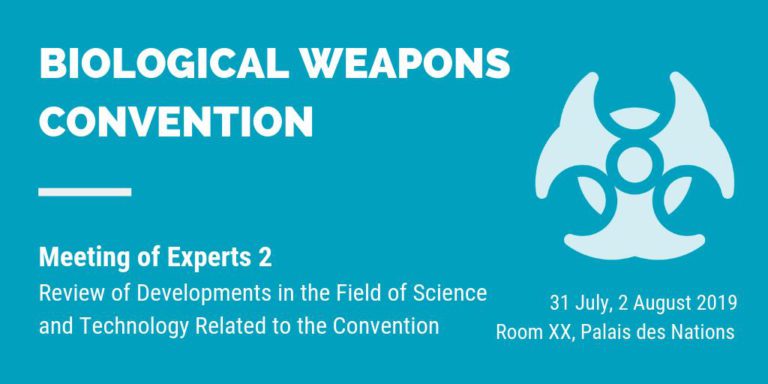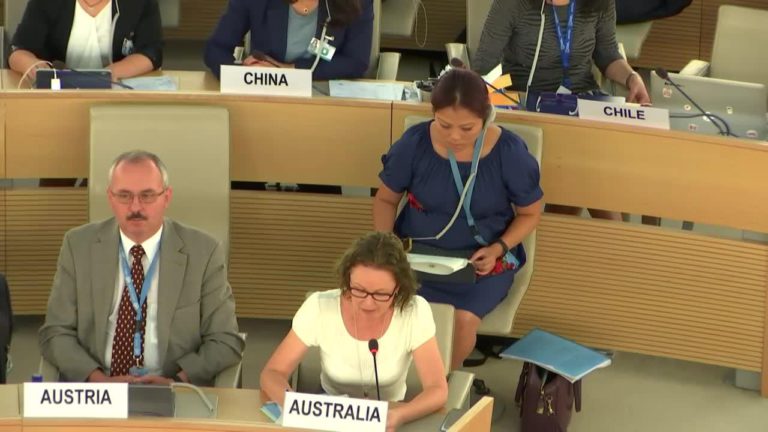Blog 2 – Experiences of a student at the Meetings of Experts of the Biological and Toxin Weapons Convention
This second blog post covers both the second and third Meetings of Experts (MXs) of the Biological and Toxin Weapons Convention (BTWC). MX2 on science and technology took place on 31 July and 2 August (the day in between being the Swiss national day); MX3 on strengthening national implementation of the BTWC was a one-day event on 5 August.
MX2 impressions
Like at the start of the week I was still sitting behind The Trench nameplate, which was formally represented for the first time in these five MXs of 2019. MX2 was chaired by Mr Yury Nikolaichik of Belarus who decided to modify the agenda order for the sake of efficiency. He thus began with the general information leading to the specifics such as national reports. This change in the order did not bother most delegations.

The conference began with four very informative technical presentation by relevant multilateral organisations and research institutes that are very much involved in the BTWC Meeting of Experts. From the Wilson Centre, Dr Eleonore Pauwels talked about the convergence of artificial intelligence, cyber development and biotechnology. Dr Jonathan Forman introduced the audience to the functioning of the Scientific Advisory Board (SAB) of the Organisation for the Prohibition of Chemical Weapons (OPCW). Dr Cheng Tang, who chairs the SAB, discussed the OPCW’s 2015 Hague Ethical Guidelines, Dr Maurizio Barbeschi of the World Health Organisation (WHO) talked about science and technology foresight and dual-use research concerns. These presentations lasted the entire morning as each were followed by multiple rounds of questions. This made the meeting very interactive and held the delegates’ attention.
Side events
Early in the morning I attended the side event presenting the report of the third workshop by the Spiez Laboratory, the Swiss Federal Institute for NBC-Protection. A very detailed outline of the conference was presented, and a lot of important information came out of it. The Q&A session that followed discussed many relevant points and raised technical questions about the new technologies and their implications.
The side event I attended on Friday morning after the Swiss national day was hosted by InterAcademy Partnership and US National Academies of Science, Engineering and Medicine: Qualitative Frameworks to Assess Risks and Benefits of Advances in Science and Technology: Opportunities for the BWC. This conference enlightened me on various aspects of risk assessment frameworks. This side event started by explaining their intention of having a quantitative framework, in order to have a systematic, structured, transparent exchange in an international group with various fields of expertise. The different panellists spoke about what a framework entails, how to use it, and how they had tested it with two case examples. On these case studies I highly appreciated the clear expression and exchange of information among the panellists and attendees, the detailed knowledge of the panellists on the topics that drew my attention. There was enough time for a Q&A session.
On this Friday afternoon, I attended the side event by the Max Planck Society entitled “Going viral? Deliberately releasing GM viruses into the environment. ” It was chaired by Dr Filippa Lentzos from King’s College London. I believe it could have continued for much longer than the two hours available. Firstly, it was original to focus on viruses and plants that are a lesser known, but equally important target of the BTWC. The panellists had different expertise that enriched the conversation about law and the deliberate release of genetically modified viruses. They covered three case studies, each of which was followed a conversation between the chair and the experts. The Q&A had to stay brief due to time-constraints but participants came up with some interesting examples and questions.
Moving into the second week

MX3 was chaired by Ms Lebogang Phihlela (South Africa) whom I would like to congratulate for proving to be a great chair in a complicated situation, in terms of late replacement and time limitations. The single day that was reserved for this important topic on national implementation of the BTWC turned out to be too short as some items on the agenda had to be cut. The day was intense, and a lot was covered which is why the delegates had to stay brief in their comments.
In the afternoon, I attended a side event by Canada, the Netherlands, Malaysia and Uganda about the Practical Tools to Enhance National Biosecurity. The panellists gave enlightening presentations about the tools that each country developed in different parts of the world. The choice of the countries presenting these tools was a successful way of providing a global overview of the progress. The Head of Biosecurity Office of the Netherlands gave his own presentation that included various tools such as:
- the self-scan tool;
- vulnerability scan to get an idea of the biosecurity level on the scale; and
- an information film on biosecurity which particularly attracted my attention. This tool explained the pillars of biosecurity in 5 minutes and was intended for students. Being one, I know from experience that films explaining such topics can sometimes be complex. It was a great method to generate national awareness and to pass that on to future generations.
As Dr Maxwell Otim Napa, from the Ministry of Science, Technology and Innovation in Uganda could not be present at this side event, the Netherlands presented his slides on the development and hosting of an inventory with human, animal and plant pathogens. The need for collaboration among different ministries on this national inventory and data collection was underlined. This tool presents an overview of high-risk pathogens, regulatory oversight, access, and biosafety and biosecurity control measures. It provides information to first responders. It also increases legislative capacity building in Uganda, which is important because law enforcement was highlighted as a driver of data collection. The slides were very clear, and the tool was well presented.
Dr Zalini Binti Yunus from Malaysia’s Ministry of Defence outlined the functioning and logic behind the biosecurity national checklist as well as the different phases of this checklist. Last but not least, Ms. Alisha Dedhar from the Centre for Biosecurity, Public Health Agency of Canada presented the Analytical approach for the elaboration of a national system of biosecurity and biosafety that is a “how to” tool composed of ten modules. This tool includes practical guidance within each module, and an e-course that will soon be available. The presentations lasted one hour and one hour was left for Q&As. The side event finished early.
The MX2 and MX3 were filled with many interventions that enriched the discussions. Alas, time shortage forced some interactions to be cut short. To see the involvement by all the delegates was encouraging.
